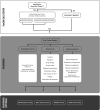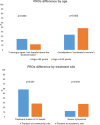Leveraging patient-reported outcomes (PROs) in patients with pancreatic cancer: The Pancreatic Cancer Action Network (PanCAN) online patient registry experience
- PMID: 34477302
- PMCID: PMC8525124
- DOI: 10.1002/cam4.4257
Leveraging patient-reported outcomes (PROs) in patients with pancreatic cancer: The Pancreatic Cancer Action Network (PanCAN) online patient registry experience
Abstract
Background: The Pancreatic Cancer Action Network (PanCAN) Patient Registry is an online, pancreatic cancer-specific, global registry enabling patients to self-report sociodemographics, disease/management characteristics, and patient-reported outcomes (PROs). We sought to describe the creation, user experience, and research potential of the PanCAN Registry.
Methods: We obtained data to describe (1) the creation of the Registry (questionnaire development, marketing efforts, and regulatory considerations); (2) the user experience (user characteristics and interactions with the registry following inception); and (3) the research potential of the registry (comparing PROs and treatment patterns by age [±65 years] and treatment site [community or academic] for users with de novo metastatic disease).
Results: The Registry was conceived as part of PanCAN's strategic plan for a personalized therapy initiative. PanCAN staff and disease expert consultants developed questionnaires hosted on an electronic PRO platform. Users had the option to include their data in research efforts, and the Registry platform received institutional review board approval. From 7/2015 to 12/2020, 2187 patients visited the registry and 1697 (77.6%) completed at least one survey (median age = 64 years [range: 24-90], 47.9% women, 88.7% White, 34.0% metastatic disease). Among patients with metastatic disease (N = 567), 46.0% were ≥65 years old and 67.5% received treatment at community sites. Patients ≥65 years reported feeling less hopeful about the treatment plan (12.4% vs. 24.3%, p = 0.003), and patients treated at community sites reported more frequent treatment breaks of >2 weeks (58.2% vs. 28.1%, p < 0.001).
Conclusions: Our findings demonstrate the feasibility, usability, and research potential of an online PRO registry for patients with cancer. This description of the PanCAN Registry should inform future registry-building efforts to facilitate standardized PRO reporting and provide a valuable research database.
Clinical trial registration number: Not applicable.
Keywords: PanCAN; pancreatic cancer; patient-reported outcomes; registry.
© 2021 The Authors. Cancer Medicine published by John Wiley & Sons Ltd.
Conflict of interest statement
None.
Figures



References
-
- Siegel RL, Miller KD, Fuchs HE, Jemal A. Cancer statistics, 2021. CA Cancer J Clin. 2021;71(1):7‐33. - PubMed
-
- Mizrahi JD, Surana R, Valle JW, Shroff RT. Pancreatic cancer. Lancet. 2020;395(10242):2008‐2020. - PubMed
-
- Seventer EE, Fish MG, Fosbenner K, et al. Associations of baseline patient‐reported outcomes with treatment outcomes in advanced gastrointestinal cancer. Cancer. 2021;127(4):619‐627. - PubMed
Publication types
MeSH terms
Grants and funding
LinkOut - more resources
Full Text Sources
Medical
Miscellaneous

